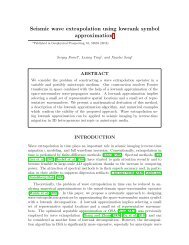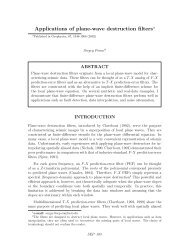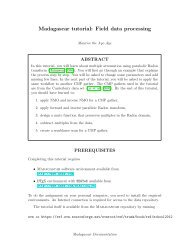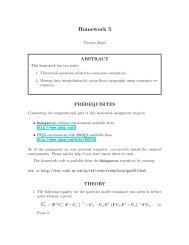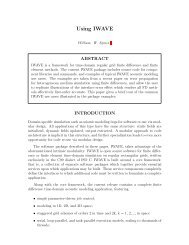single PDF file - Madagascar
single PDF file - Madagascar
single PDF file - Madagascar
You also want an ePaper? Increase the reach of your titles
YUMPU automatically turns print PDFs into web optimized ePapers that Google loves.
<strong>Madagascar</strong> Documentation Tutorial 3<br />
• Fetch, Flow, Plot, and Result are defined in <strong>Madagascar</strong>’s rsf.proj<br />
package, which extends the functionality of SCons .<br />
4. To better understand how rules translate into commands, run<br />
bash$ scons -c cmp.rsf<br />
The -c flag tells scons to remove the cmp.rsf <strong>file</strong> and all its dependencies.<br />
5. Next, run<br />
bash$ scons -n cmp.rsf<br />
The -n flag tells scons not to run the command but simply to display it on the<br />
screen. Identify the lines in the SConstruct <strong>file</strong> that generate the output you<br />
see on the screen.<br />
6. Run<br />
bash$ scons cmp.rsf<br />
Examine the <strong>file</strong> cmp.rsf both by opening it in a text editor and by running<br />
bash$ sfin cmp.rsf<br />
Part Two<br />
Figure 3(a) shows a CMP gather from Canterbury data set Line 12. The multiple<br />
energy appears at time around 2.25 s. Figure 6 shows the same gather after applying<br />
NMO correction with veloctiy equals to 1500 m/s. The multiple events starting at<br />
around 2.25 s and below are flatened while primary events , e.g at 2 s, are over<br />
corrected. The difference in move-out between the primaries and multiples , hence,<br />
can be used in Radon domain to attenuate multiple energy. Figure 2(a) is generated by<br />
forward parabolic Radon transform while Figure 1(d) is generated by inverse parabloic<br />
Radon transform. The purpose was to make sure that forward and inverse transforms<br />
do not cause any data loss.<br />
Figure 2(a) shows the Radon transform of the CMP gather in Figure 3(a) while<br />
Figure 2(b) shows in the Radon domain the multiple energy only after mutting the<br />
primary energy. The protected multiples can be taken back to the time-offset domain<br />
and are subtracted from the data.<br />
CMP gather before multiple attenuation is shown in Figure 3(a) and the coresponding<br />
semblance scan is shown in Figure 3(c). The CMP gather after multiple<br />
attenuation is shown in Figure 3(b) and the coresponding semblance scan is shown in<br />
Figure 3(d). The semblance scans show how multiple energy is reduced for the CMP<br />
gather after multiple attenuation.



